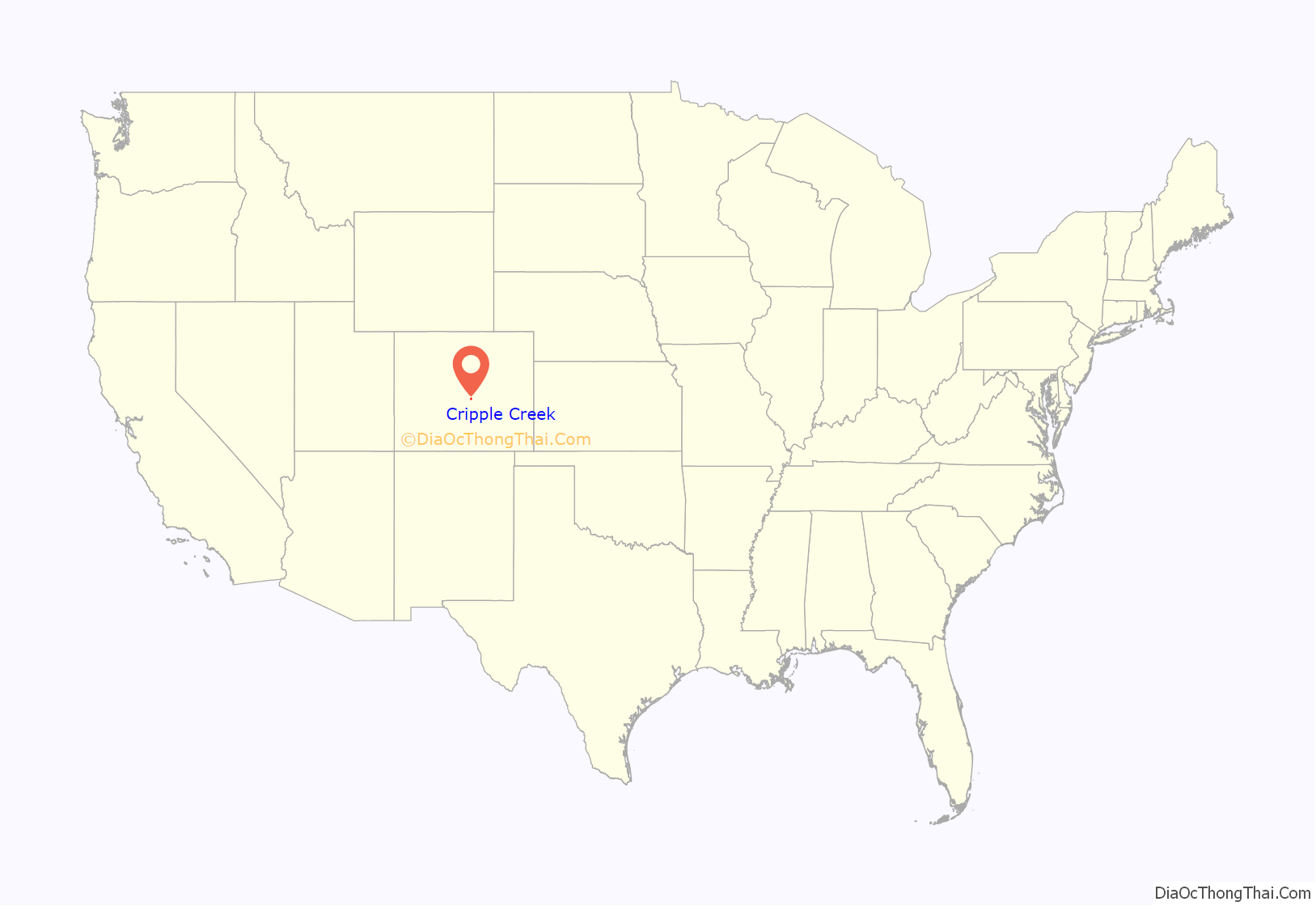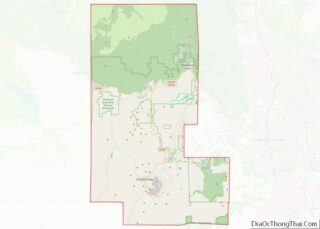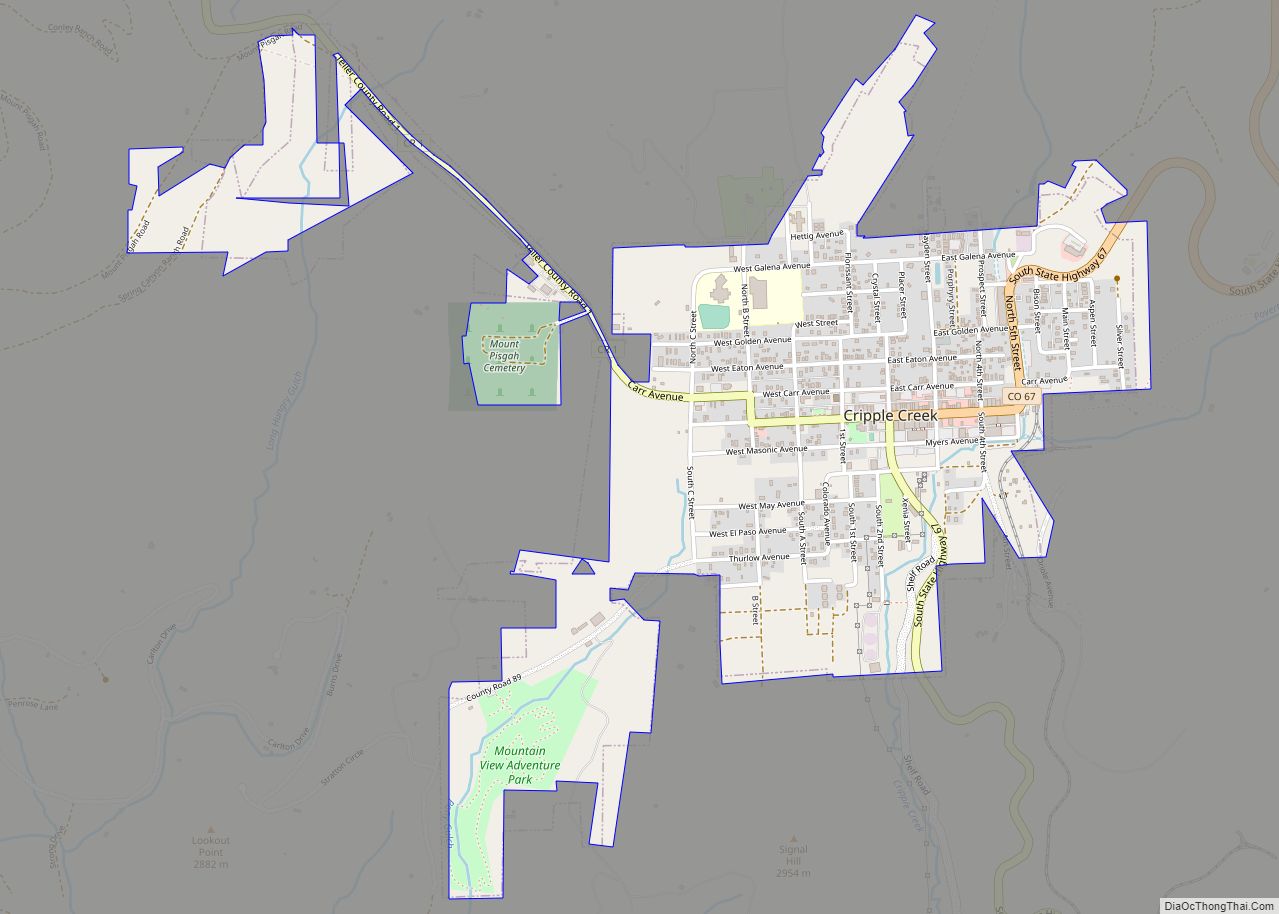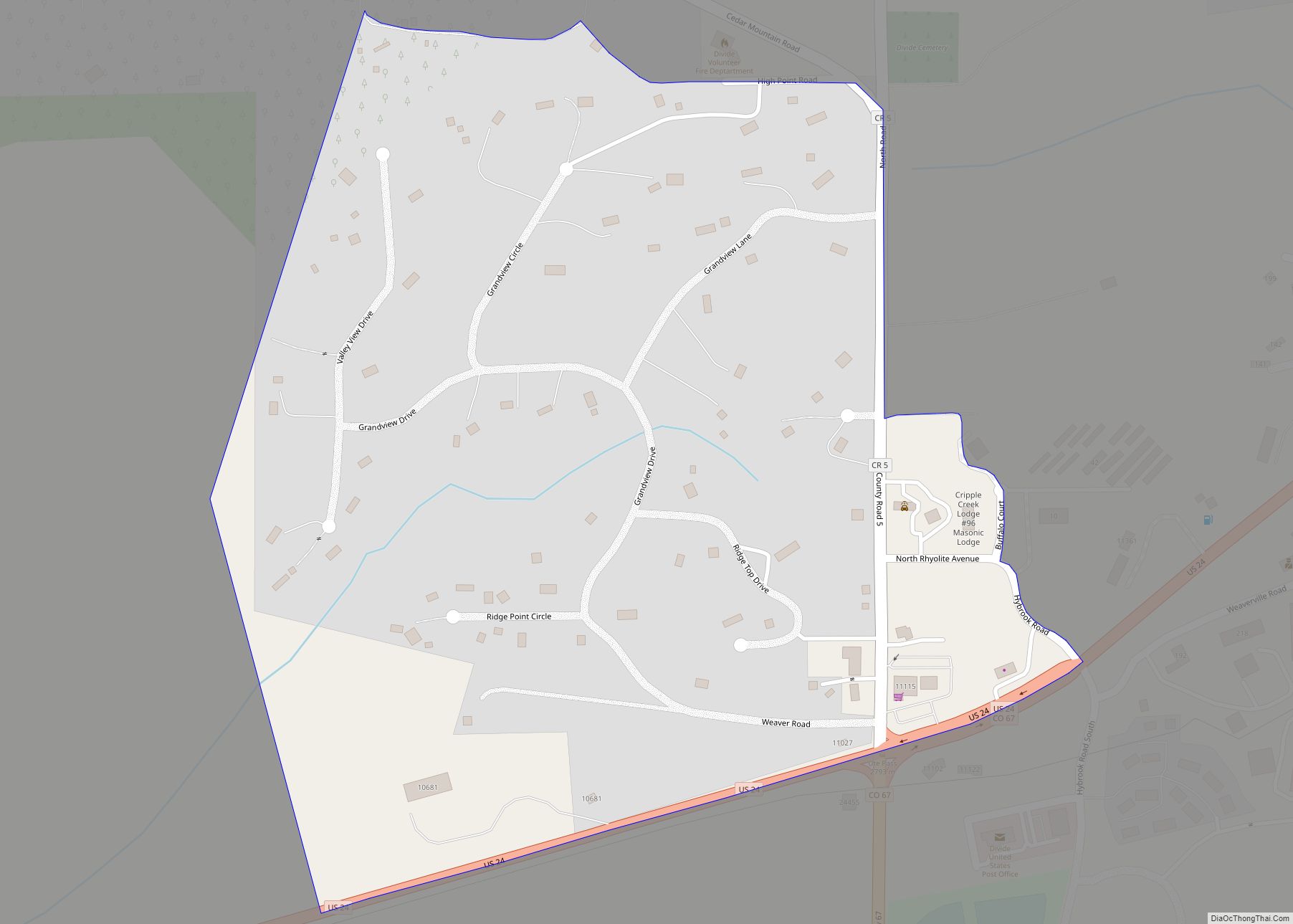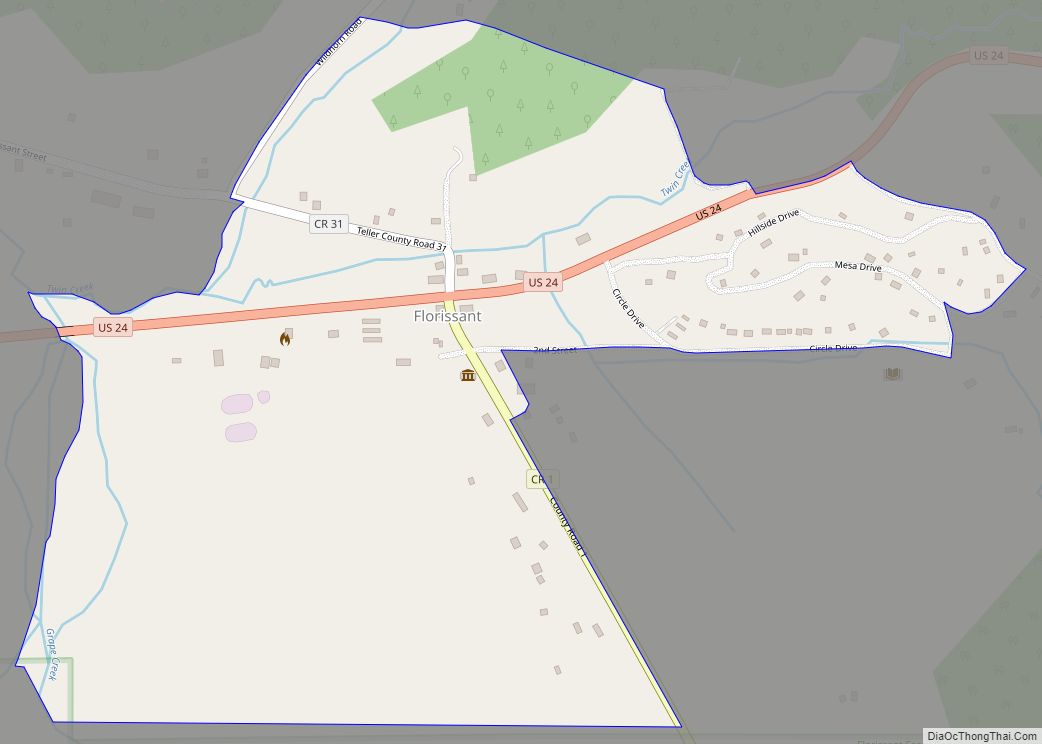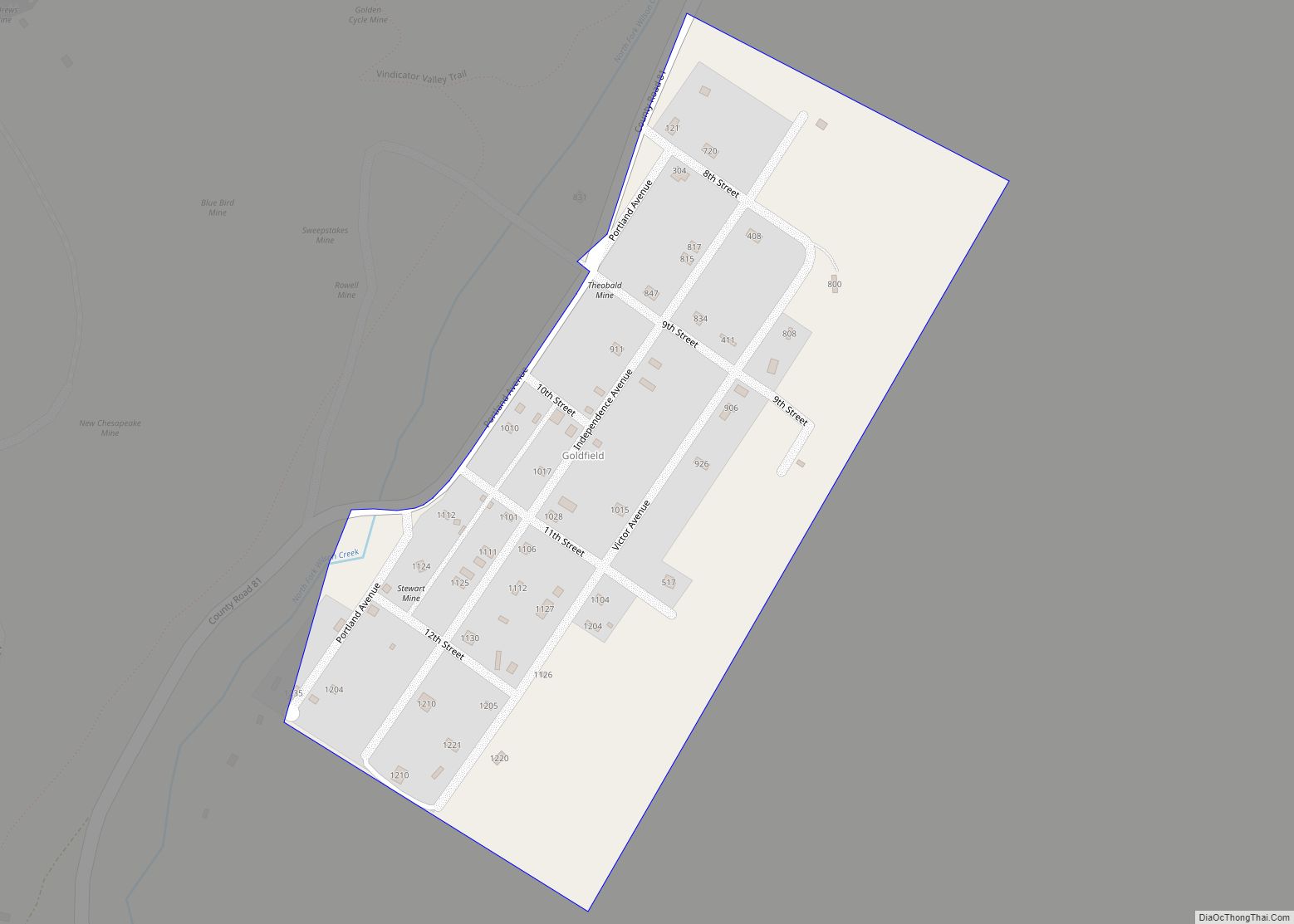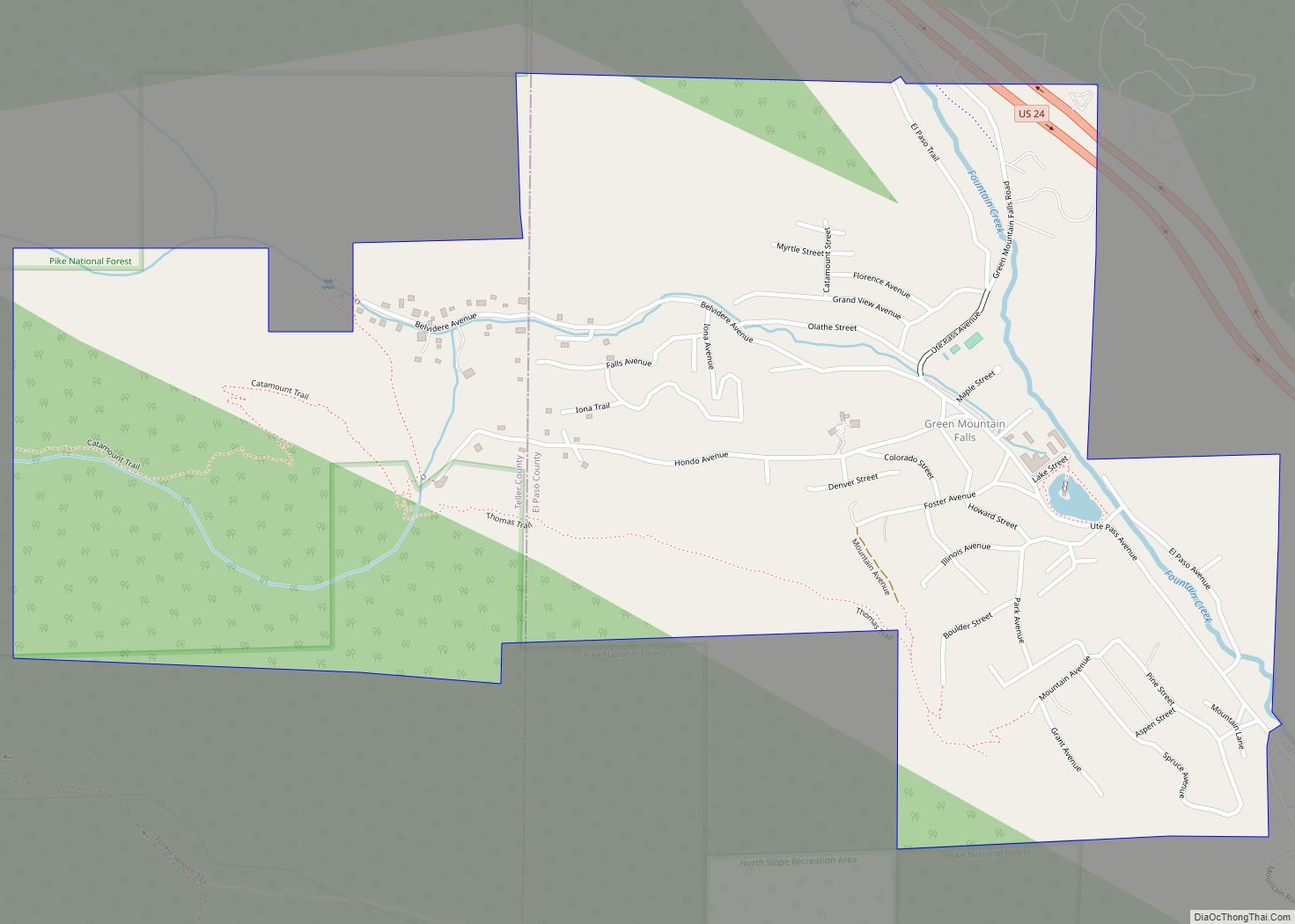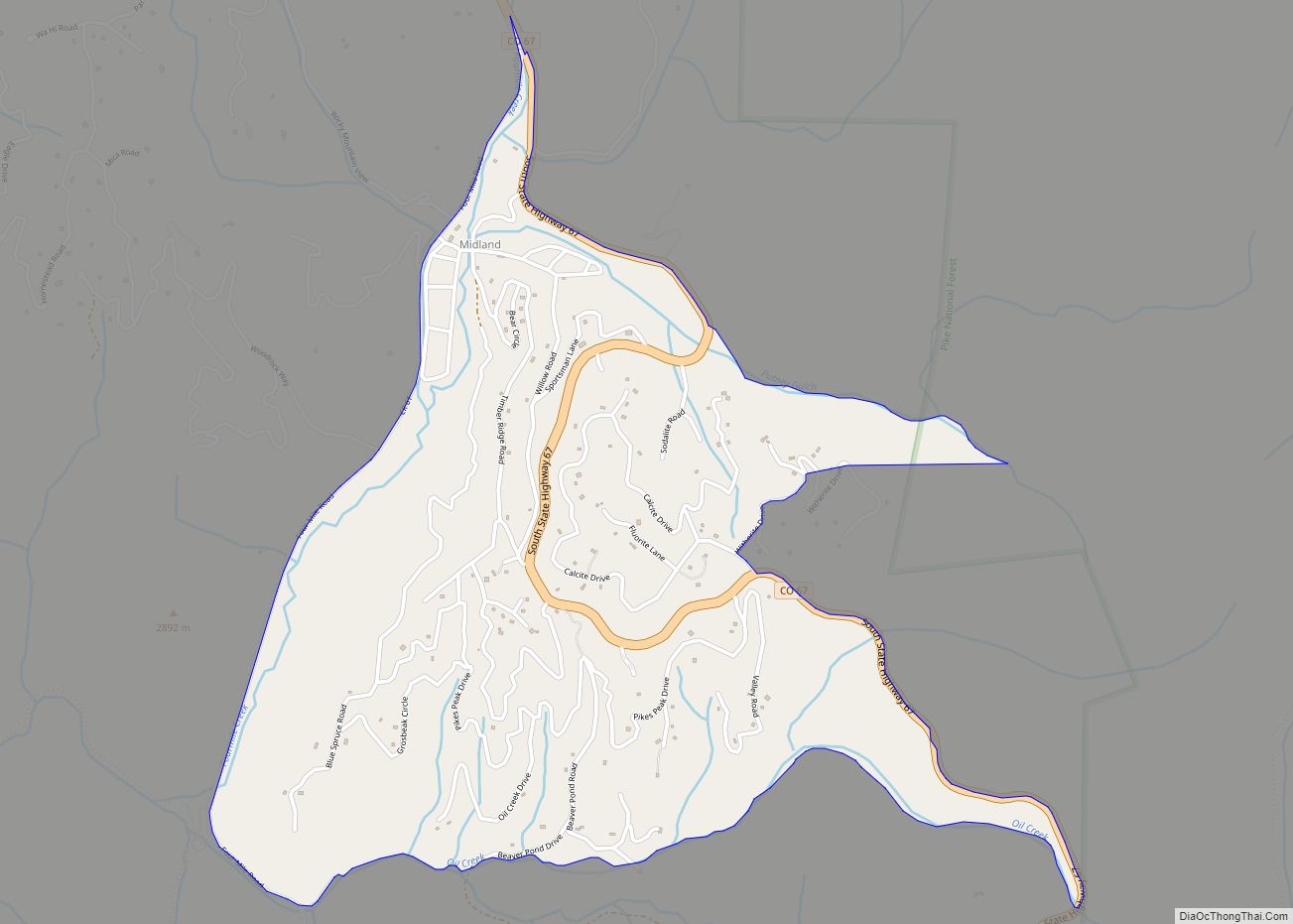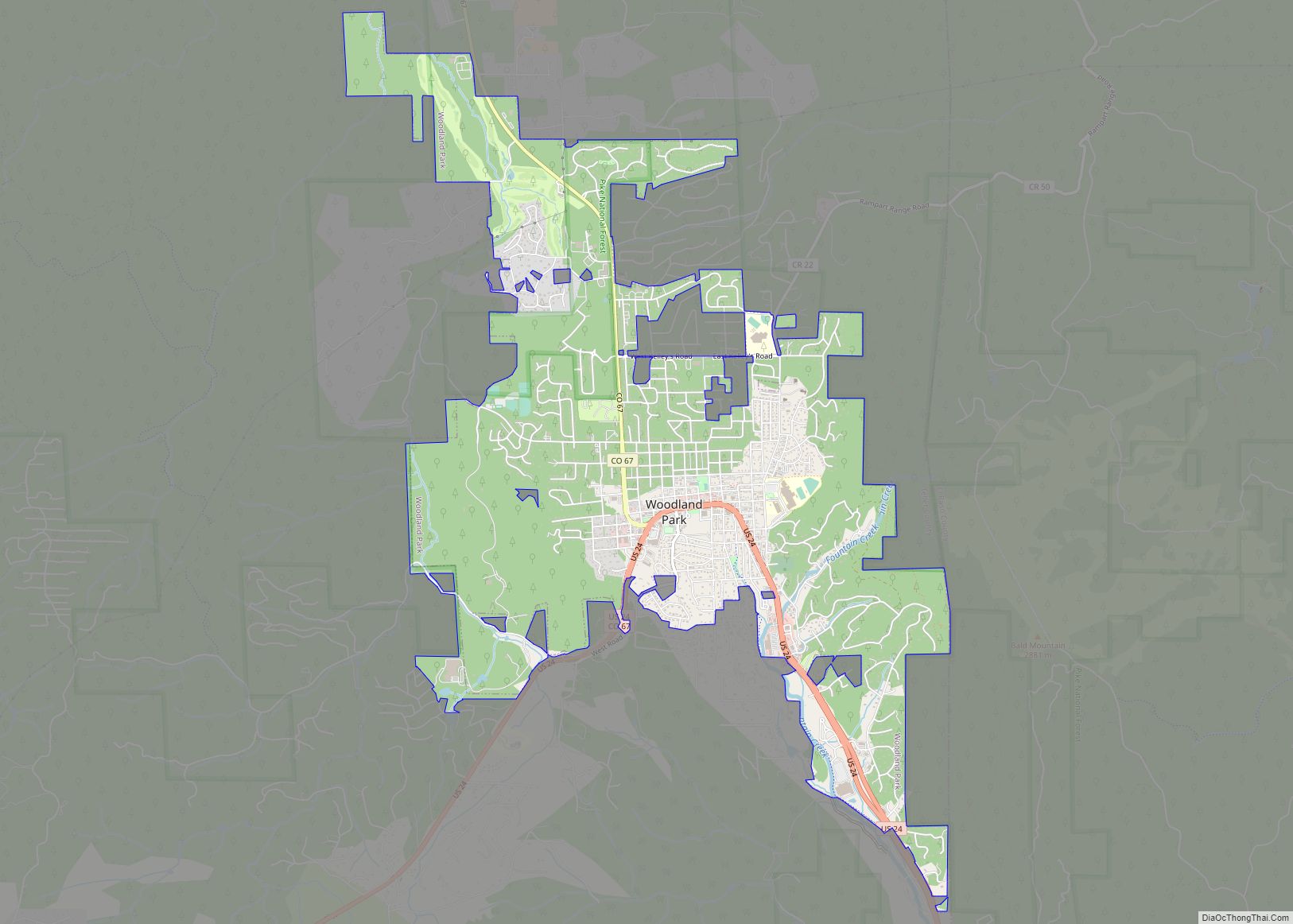Cripple Creek is a statutory city that is the county seat of Teller County, Colorado, United States. The city population was 1,155 at the 2020 United States Census. Cripple Creek is a former gold mining camp located 20 miles (32 km) southwest of Colorado Springs near the base of Pikes Peak. The Cripple Creek Historic District, which received National Historic Landmark status in 1961, includes part or all of the city and the surrounding area. The city is now a part of the Colorado Springs, CO Metropolitan Statistical Area and the Front Range Urban Corridor.
| Name: | Cripple Creek city |
|---|---|
| LSAD Code: | 25 |
| LSAD Description: | city (suffix) |
| State: | Colorado |
| County: | Teller County |
| Incorporated: | June 9, 1892 |
| Elevation: | 9,494 ft (2,894 m) |
| Total Area: | 1.522 sq mi (3.941 km²) |
| Land Area: | 1.522 sq mi (3.941 km²) |
| Water Area: | 0.000 sq mi (0.000 km²) |
| Total Population: | 1,155 |
| Population Density: | 760/sq mi (290/km²) |
| ZIP code: | 80813 |
| Area code: | 719 |
| FIPS code: | 0818530 |
| Website: | cityofcripplecreek.com |
Online Interactive Map
Click on ![]() to view map in "full screen" mode.
to view map in "full screen" mode.
Cripple Creek location map. Where is Cripple Creek city?
History
For many years, Cripple Creek’s high valley, at an elevation of 9,494 feet (2,894 m), was considered no more important than a cattle pasture. Many prospectors avoided the area after the Mount Pisgah hoax, a mini gold rush caused by salting (adding gold to worthless rock).
On 20 October, 1890, Robert Miller “Bob” Womack discovered a rich ore and the last great Colorado gold rush began. By July 1891, a post office was established. By November, hundreds of prospectors were camping in the area. Rather than investing in mines, Denver realtors Horace Bennett and Julius Myers sought wealth by platting 80 acres of land for a townsite which they named Fremont. The town consisted of 30 platted blocks containing 766 lots. Each lot sold for $25 and $50 for corner lots. Within a year, the lots value increased and sold for at least $250 each. Months later, investors from Colorado Springs platted 140 acres near Fremont and called their town Hayden Placer. Bennett and Myers filed another plat near the Broken Box Ranch and named it Cripple Creek. The towns’ combined population total 600-800 people by the end of 1891. By 1892, the Cripple Creek Mining District name had caught on and in June 1892, the post office assigned the Cripple Creek name to Fremont, Hayden Placer, and Cripple Creek and all the settlements became known as one. From 1892, Bennett and Myers oversaw the Fremont Electric Light and Power Company. The district’s first telephone was established in 1893. Thousands of prospectors flocked to the district, and before long Winfield Scott Stratton located the famous Independence lode, one of the largest gold strikes in history. In three years, the population increased from five hundred to ten thousand. The Palace Hotel and the Windsor Hotel were so full that chairs were rented out to be slept on for $1 a night. Although $500 million worth of gold ore was dug from Cripple Creek and more than 30 millionaires were produced since its mining heyday, Womack was not among them. Having sold his claim for $500 and a case of whiskey, he died penniless on 10 August 1909. By 1892, Cripple Creek was home to 5,000 people with another 5,000 in the nearby towns of Victor, Elton, Goldfield, Independence, Alton, and Strong. As people arrived, the marshal greeted them and confiscated their firearms, which were then sold in Denver to pay for the salary of the teachers of Cripple Creek.
In 1896, Cripple Creek suffered two disastrous fires. The first occurred on April 25 with flames resulting from a dispute between a bartender, Otto Floto, and his dancehall girlfriend, Jennie Larue, on the second floor of the Central Dance Hall on Myers Avenue. Their struggle resulted in an oil lamp being thrown setting fire to the curtains. The fire incinerated most buildings on Myers Avenue before it was put out. Four days later, another fire destroyed much of the remaining half. A cook at the Portland Hotel spilled a kettle of grease on a hot stove, which caused fire to travel from Myers to Bennet Avenue and burned 1/3 of Cripple Creek. The town was rebuilt using brick and better construction methods in a period of a few months; most historic buildings today date back to 1896.
By 1900, the Cripple Creek mining district was home to 500 mines. By 1910, it had produced 22.4 million ounces of gold. Between 1894 and 1902, around 50,000 people lived in the mining district with 35,000 in the town of Cripple Creek alone making it the fourth most populous town in Colorado at the time. The seven adjoining boom towns includes Victor, Gillette, Alban, Independence, Goldfield, Elton, and Cameron—all of which were connected by rail. During the boom, there were 150 saloons, 49 grocery stores, 25 restaurants, four department stores, 12 casinos, 34 churches, a business college, a county school district with 19 schools and 118 teachers educating almost 4,000 students, 90 doctors, 40 stockbrokers, 15 newspapers, 9 assay offices, 10 barber shops, 72 lawyers, 20 houses of ill-repute, over 300 prostitutes, 26 one room cribs, and several opium dens. Prostitution flourished until the 1920s and was taxed at a rate of $6 a month per prostitute and $16 a month per madame. Pearl De Vere, a famous madame who owned The Old Homestead, a high class brothel that serviced wealthy mine owners and entrepreneurs of the area, was known to have charged clients in the upwards of $250 a night. Over 8,000 miners worked in the district making $3 per day. Most miners and foremen supplemented their incomes by as much as 1/3 through high grading. It was estimated that an average of $1–2 million dollars per year were stolen from the early mines through high grading.
While $3 a day was typical for a miner, some miners had to work 8 hours a day while others had to work 9 or 10 hours. The average miners paid $1.75 per week for an unfurnished house or $2.50 per week to boarding houses that included a room, bath, and meals. During the 1890s, many of the miners in the Cripple Creek area joined a miners’ union, the Western Federation of Miners (WFM). A significant strike took place in 1894, marking one of the few times in history that a sitting governor called out the national guard to protect miners from anti-union violence by forces under the control of the mine owners. By 1903, the allegiance of the state government had shifted, and Governor James Peabody sent the Colorado National Guard into Cripple Creek with the goal of destroying union power in the gold camps. The WFM strike of 1903 and the governor’s response precipitated the Colorado Labor Wars, a struggle that took many lives.
The 1904 silent film short, Tracked by Bloodhounds; or, A Lynching at Cripple Creek, directed by Harry Buckwalter, was filmed in the area.
Through 2005, the Cripple Creek district produced about 23.5 million troy ounces (979 1/6 troy tons; 731 metric tons) of gold. The underground mines are mostly idle, except for a few small operations. There are significant underground deposits remaining which may become feasible to mine in the future. Large scale open pit mining and cyanide heap leach extraction of near-surface ore material, left behind by the old time miners as low grade, has taken place since 1994 east of Cripple Creek, near its sister city of Victor, Colorado. The district’s population began declining starting in 1905 as mines began closing. By 1920, only 40 mines were in business, and by 1945 the number dwindled to just 20 mines.
The current mining operation is conducted by Cripple Creek & Victor Gold Mining Company (CC&V), run currently by Newmont Mining. The mine operates 24 hours a day, 365 days a year. Mine operations, maintenance, and processing departments work a rotating day/night schedule in 12-hour shifts.
With many empty storefronts and picturesque homes, Cripple Creek once drew interest as a ghost town. At one point, the population dropped to a few hundred, although Cripple Creek was never entirely deserted. In the 1970s and 1980s, travelers on photo safari might find themselves in a beautiful decaying historic town. A few restaurants and bars catered to tourists, who could pass weathered empty homes with lace curtains hanging in broken windows.
Colorado voters allowed Cripple Creek to establish legalized gambling in 1991. Cripple Creek is currently more of a gambling and tourist town than a ghost town. Casinos now occupy many historic buildings. Casino gambling has been successful in bringing revenue and vitality back into the area. It also provides funding for the State Historical Fund, administered by the Colorado Office of Archaeology and Historic Preservation. In 2012, Colorado casinos produced over $104 million in tax revenue for these programs.
Cripple Creek Road Map
Cripple Creek city Satellite Map
Geography
The gold-bearing area of the Cripple Creek district was the core of an ancient volcano within the central Colorado volcanic field, last active over 30 million years ago during the Oligocene. Free or native gold was found near the surface but at depth unoxidized gold tellurides and sulfides were found.
At the 2020 United States Census, the town had a total area of 974 acres (3.941 km), all of it land.
The community takes its name from nearby Cripple Creek.
See also
Map of Colorado State and its subdivision:- Adams
- Alamosa
- Arapahoe
- Archuleta
- Baca
- Bent
- Boulder
- Broomfield
- Chaffee
- Cheyenne
- Clear Creek
- Conejos
- Costilla
- Crowley
- Custer
- Delta
- Denver
- Dolores
- Douglas
- Eagle
- El Paso
- Elbert
- Fremont
- Garfield
- Gilpin
- Grand
- Gunnison
- Hinsdale
- Huerfano
- Jackson
- Jefferson
- Kiowa
- Kit Carson
- La Plata
- Lake
- Larimer
- Las Animas
- Lincoln
- Logan
- Mesa
- Mineral
- Moffat
- Montezuma
- Montrose
- Morgan
- Otero
- Ouray
- Park
- Phillips
- Pitkin
- Prowers
- Pueblo
- Rio Blanco
- Rio Grande
- Routt
- Saguache
- San Juan
- San Miguel
- Sedgwick
- Summit
- Teller
- Washington
- Weld
- Yuma
- Alabama
- Alaska
- Arizona
- Arkansas
- California
- Colorado
- Connecticut
- Delaware
- District of Columbia
- Florida
- Georgia
- Hawaii
- Idaho
- Illinois
- Indiana
- Iowa
- Kansas
- Kentucky
- Louisiana
- Maine
- Maryland
- Massachusetts
- Michigan
- Minnesota
- Mississippi
- Missouri
- Montana
- Nebraska
- Nevada
- New Hampshire
- New Jersey
- New Mexico
- New York
- North Carolina
- North Dakota
- Ohio
- Oklahoma
- Oregon
- Pennsylvania
- Rhode Island
- South Carolina
- South Dakota
- Tennessee
- Texas
- Utah
- Vermont
- Virginia
- Washington
- West Virginia
- Wisconsin
- Wyoming
